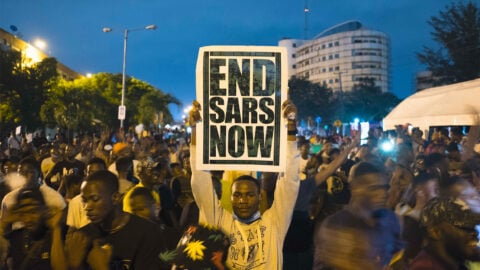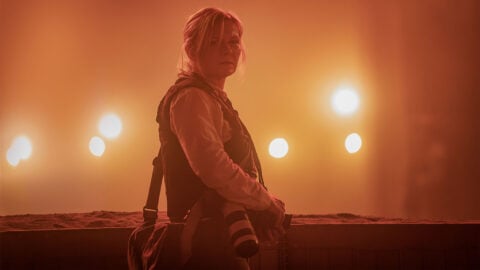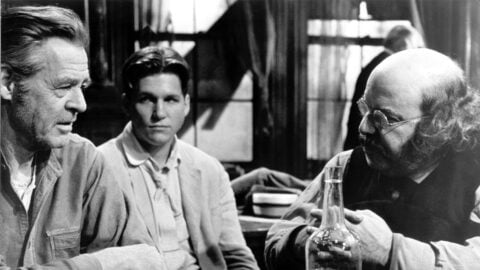Art of the Real: Edgardo Cozarinsky

One of Edgardo Cozarinsky’s short stories pivots on a sentence that exemplifies the delicate tone—tender, sympathetic, gently ironic, a little tersely evaluative—of the Argentine writer-filmmaker’s many evocations of transatlantic émigré life. In the story (“Days of 1937”) a German pianist, having left his country during World War II, drifts through the Buenos Aires he’s come to call his home. He makes a living playing regular sets at a sparsely attended café where, once a night, he’s brought a small bowl of cocaine to keep his spirits up. Recently, he has been surprised to start getting a series of anonymous requests for German songs he thought only he remembered. One night he walks down to the edge of the city, where he believes he hears “the promising murmur of engines now at rest but which at any moment could roar into life and push these floating palaces off towards Europe.” He looks out over the water:
He saw the Rio de la Planta, like the Atlantic Ocean it was part of, exclusively in terms of the distance that separated him from Europe; it would have been pointless to remind him that if he had traveled out in a straight line, he would have come to Cape Town: in the map of his imagination there was only one cardinal-point: north-northeast.
What does it look like to try to reconstruct the cardinal-points of a person’s imagination, to look at a city exclusively in terms of its distance from another, distant one, or to track the movements of one’s parents and grandparents from continent to continent and port to port? The characters in Cozarinsky’s 2001 collection The Bride from Odessa, in which “Days of 1937” appears, often end up playing detective with their own past. An aging Argentinian man happens upon a translation of a devastating letter his Russian-language teacher received in 1946. An art forger of Argentine extraction travels to Budapest, the city of his mother’s birth, in search of a rare painting lost during the war. A writer on a stay in Lisbon tries to reconstruct the brief period his grandparents—a New York heiress and a German émigré whose identity may have been forged—stayed in that city before emigrating to America and giving birth to a daughter who would, in turn, settle for a time in Buenos Aires.

Many of Cozarinsky’s stories are laced with elements of their author’s family history. One way to look at Letter to a Father, Cozarinsky’s exquisite new essay film, is as another angle on the historical event behind the title story of The Bride from Odessa: the massive initiative sponsored in the 1890s by the German banker Maurice de Hirsch to fund and support Jewish immigration from Eastern Europe to pre-established agricultural colonies in, among other countries, central Argentina. In that story, a young man meets a Russian Orthodox shopgirl, a stranger to him, during a brief stay in Odessa. He is on his way from his home in Kiev, he tells her, to start a new life in the Argentine province of Entre Ríos. (“He explained to her that . . . on the other side of the ocean there was a land of infinite possibilities, a country where a Jew like him could own a piece of land.”) He confesses that the young woman he’d recently, unhappily married had refused to join him on the trip—at which the shopgirl insists, “laughing all the while,” that he take her with him instead.
The story ends with the eventual couple’s great-great-grandson laid up in a hospital bed, where he learns about the secret of his distant parentage in a letter from his aunt and resolves “to write it as a story.” Cozarinsky, who was born in Buenos Aires in 1939, was indeed undergoing cancer treatments in a hospital around the time that he wrote “The Bride from Odessa.” Until then, he had published relatively little, save for a single, relatively successful novel (Urban Voodoo, 1985). His international reputation as a filmmaker, on the other hand, was well established. In 1974, as bloody conflicts were breaking out in Argentina between ultra-right-wing paramilitary groups and guerillas associated with the Peronist left, he left Buenos Aires for Paris. Not having prepared for a long-term stay—he would have preferred London—he started calling the city home. Living abroad as the violence in his home country intensified, he developed a deep interest in Paris’s wartime history. One Man’s War, the collage movie Cozarinsky made in 1981 out of newsreel footage of the occupied city and readings of Ernst Junger’s diaries from the time, remains his best-known film.
Cozarinsky re-visited Buenos Aires in the early Nineties, and Sunset BoulevardS, the essay film he made about the city in 1992, anticipates many of the devices on which he would depend in Letter to a Father. Like the new movie, it sets up Cozarinsky as a sort of detective figure combing Argentina for traces of persons exiled or displaced. In Sunset BoulevardS, the persons in question are Maria Falconetti, the legendary star of The Passion of Joan of Arc who moved to the city from Brazil in 1943 under tight financial strain, and Robert Le Vigan, a French actor forced into exile on account of his strong fascist ties. The movie alternates between interviews with the pair’s acquaintances, testimonies from the city’s old hands (including Cozarinsky’s longtime friend Adolfo Bioy Casares), excerpts from pre-war movies, snippets of newsreels, and restless urban footage shot on the fly.

Cozarinsky’s own presence in Sunset BoulevardS is cagier and more reticent than in the new film. But the earlier movie is no less driven by his need to pin down what, exactly, his Jewish family’s position was during his childhood in Argentina, which persisted in its stubborn, tense neutrality for much of the Second World War. At one point in the film, he reminisces about being taken as a boy to hear Falconetti join in a singing of the Marseillaise immediately after the liberation of Paris. (The words, sung in a language he didn’t know, went over his head.) That memory recurs at an important juncture in Letter to a Father, as does a memorable line near the end of Sunset BoulevardS: “Every detective always ends up learning something about himself.”
Like the young man in “The Bride from Odessa,” Cozarinsky’s grandfather readily took the chance given him by Baron Hirsch’s relocation project. He left Odessa on August 10, 1984 for “Colonia Clara” in Entre Ríos, a province that Cozarinsky, as he confesses in the opening scene of Letter to a Father, never visited until the movie’s making. It is, in fact, the story of this grandfather of Cozarinsky’s—and the legacy of the Jewish immigrant population in Entre Ríos—to which much of the movie turns out to be devoted: the couple’s fortnight-long layover in a shack-like “immigrant hotel” in Domínguez; the library the new arrivals built there; the safe in which the more prosperous among them pooled their money to help their less fortunate settlers keep their land; the two museums in Entre Ríos filled with the early immigrants’ trinkets, tea sets, phonographs and books; the cemetery where “Abram Kazarinsky”—as he is named on the log of the ship that bore him over from Odessa—lies under a stern-looking portrait taken of him in his later years; the moving letter he wrote in pained, formal Spanish script to his son after the latter joined the Navy and left for America in 1919.
Here Cozarinsky’s strategy is to accumulate details with scrupulous attention, letting the world in which his father grew up—and the people to whom he grew up—gain in texture and presence with the revelation of each new image, the unveiling of each new site and the disclosure of each new fact. For Cozarinsky to ask about his father’s life directly means, in contrast, bombarding the movie with questions. “What made that child of ‘Jewish gauchos’ dare join the Navy at 18?” he asks in one voiceover passage. Another line of questioning plays over a languorous shot of a misty river running through Villa Clara: “Did he ever miss this river, these fields, this sky?” “What did he find in his travels?” “Where can I find answers?”

Not, it’s suggested, in the many old photographs through which we see Cozarinsky leafing over the course of the film, nor in the colorful, exotic postcards he received throughout his childhood as a Navy son, nor from the inscription on the seppuku knife his father brought him back from Japan as a gift. It’s basic to the movie’s design that its assertive, swelling dominant melody keeps giving way to these tentative, less confident passages of interrogation or doubt. Cozarinsky lost his father at 20. Theirs was, he admits at one point in the film, a relationship in which little time was spent together and from which little was learned. What survives from it now are—above all—the letters, to which you could read Letter to a Father as a belated reply. (The epistolary film, as the scholar Hamid Naficy once pointed out, has historically lent itself well to cinemas of diaspora or exile. Consider, as he does, Chris Marker’s Letter from Siberia, Chantal Akerman’s News from Home, Mona Hatoum’s Measures of Distance and Tangos: The Exile of Gardel by Fernando Solanas, another major Argentine filmmaker forced to re-locate to Paris during the military junta’s reign of terror in his home country.) To Cozarinsky, the author of those letters stayed partially undefined. If memory serves, we never hear his name.
Ignorance, it should be said, is less what defines the Cozarinsky character than his ruminative streak. He is a hawk-like, severe man furrowing his brow at the passage of a city by the windows of his car, a deliverer of half-whispered soliloquies about the need to compile and conserve what records of the past one can, and a eulogist standing in a cemetery at nightfall, reflecting on just how many failures met the 19th-century immigrants buried under his feet. Letter to a Father is well-stocked with colorful family anecdotes—a beautiful 21-year-old girl, one of Cozarinsky’s aunts remembers, was called up for military duty one summer on account of an error by a drunken clerk—and casual, tender portraits of the current inhabitants of Entre Rios. But it depends for many of its grander effects on a deepening of its voice, a stretching out of its vowels and a rumbling of its consonants; its five-minute-long penultimate shot, set to the only piece of non-diegetic music in the film, is of sunset slowly fading into dusk.

Many of Cozarinsky’s stories depend just as heavily on his ability to introduce—and alleviate—this heaviness of tone. Most often, it’s deployed in connection with a time slipped by, a relative lost or a homeland painfully abandoned. It’s sometimes jarring to encounter these heavier, more ruminative sections in what is otherwise the mellow, inquisitive flow of Letter to a Father, but they play a clever rhetorical role for the movie. Watching them, I was reminded of an exchange that takes place near the end of “Émigré Hotel,” the long final story in The Bride from Odessa, between a wizened Lisbon bookshop owner and the younger man who’s sought him out for information about his grandparents’ convoluted early life. “For people living there in those days,” the shopkeeper has just insisted, “there was nothing romantic or novelesque about . . . Lisbon in 1940.” (Nothing, in other words, in connection with which it would be worth filming a day’s five-minute journey into night.) “I would have liked to explain to him,” the younger man thinks,
that there was a lot of romance and fiction about it, that perhaps one needed not to have lived “there, in those days,” but to have been born much later to be able to appreciate, from a radically different world, how romantic and novelesque a simple name and date—Lisbon, 1940—could be to the imagination of someone like me.
One of the strengths of Letter to a Father is that, like several of Cozarinsky’s films, it shows an active imagination scanning over and sifting through a particularly tumultuous period in world history: guessing, making inferences, tracing out possibilities, worrying over loose ends. (“I cannot help wondering,” Cozarinsky asks of a group of schoolgirls glimpsed in a photograph from his father’s Japanese tour, “if these little girls in 1940 survived the nuclear destruction of their country five years later.”) To many ears, the mention of Entre Rios in 1894 wouldn’t carry the “romantic and novelesque” charge of that of Lisbon in 1940—nor, for that matter, that of Paris in 1944 or Austria in 1938. It’s in this respect that Cozarinsky’s nimble film is as much an argumentative essay as it is a letter or a poem. If the stories of the Jews who left Odessa for Argentina just before the 20th century haven’t yet entered the canon of pre-war displacement narratives, the movie insists, they are no less rich with detail, incident and texture for it—no less deserving of proper eulogizing, nor, as the case may be, of some detective work.







